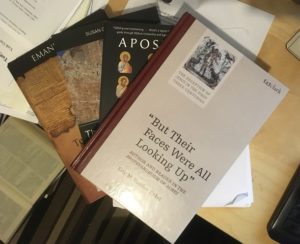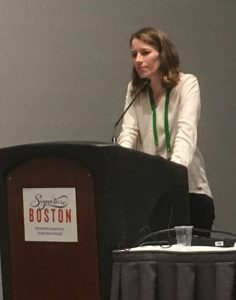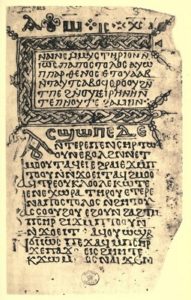2017 SBL Diary: Day Two
My second day at the 2017 SBL began with my first Journal of Biblical Literature Editorial Board meeting. I was surprised to see so many people around the table (and so many people that I know). The large number of submissions to the journal means that a large number of manuscript referees are needed, especially if they want to process them in a reasonable amount of time. Apparently there are two Christian Apocrypha (or “other”) editors: me and Pierluigi Piovanelli. I’ve joked that I took this position because it’s the only way I’ll get my name in JBL; John Marshall (University of Toronto) pointed out that it will be in every issue for the next few years!
After the meeting, I went to my first session of the day: Corpus Hellenisticum Novi Testamenti’s presentation of papers from the new Richard Pervo festschrift Delightful Acts. The session included a paper by NASSCAL Vice-President Janet Spittler (University of Virginia) entitled “Joking and Play in the Acts of John.” She opened with statement by John Chrysostom (Hom. Heb. xv) that Jesus never laughed. That may be true for the Jesus of the New Testament but he laughs plenty in apocryphal texts. Spittler looked at three case studies of Christian humor from the Acts of John: when John jokes with Lycomedes about John’s portrait (26–29), the obedient bed bugs (called by the writer “a certain comic act,” 60–61), and the episode when John sees Jesus in many forms, including a “small person” who does “a joking tug” on John’s beard (90). Though the text has plenty of dark material, Spittler said its overall theme is on how to respond to crisis—rather than live in despair, John says the present age is a time for joy.
 The one apocrypha paper of the morning finished, I popped over to the book display for a few more purchases (Susan Docherty’s The Jewish Pseudepigrapha and Emmanuel Tov’s Textual Criticism of the Hebrew Bible from Fortress and a free copy of Tom Bissell’s Apostle: Travels Among the Tombs of the Twelve from Random House) before meeting up for lunch with Steve Wiggins of Oxford University Press. Steve is helping me fine-tune a proposal I submitted to Oxford a few months ago. This was my first time being wined and dined by a publisher (i.e., he paid for lunch—I should have ordered the steak!); last year I was too timid to approach the publishing reps, this year they’re coming to me. This is nice. Of course, that means I have to write something. Ugh.
The one apocrypha paper of the morning finished, I popped over to the book display for a few more purchases (Susan Docherty’s The Jewish Pseudepigrapha and Emmanuel Tov’s Textual Criticism of the Hebrew Bible from Fortress and a free copy of Tom Bissell’s Apostle: Travels Among the Tombs of the Twelve from Random House) before meeting up for lunch with Steve Wiggins of Oxford University Press. Steve is helping me fine-tune a proposal I submitted to Oxford a few months ago. This was my first time being wined and dined by a publisher (i.e., he paid for lunch—I should have ordered the steak!); last year I was too timid to approach the publishing reps, this year they’re coming to me. This is nice. Of course, that means I have to write something. Ugh.
The afternoon was an embarrassment of riches for apocrypha papers, but of course they were all scheduled in multiple session at the same time. I decided to take in the Ancient Fiction and Early Christian and Jewish Narrative session where Eric Vanden Eykel (Ferrum College) was presenting his paper, “‘Then Suddenly, Everything Resumed Its Course’: The Suspension of Time in the Protevangelium of James Reconsidered.” Eric promised to give me a copy of his book (“But Their Faces Were All Looking Up”: Author and Reader in the Protevangelium of James), so I thought this would be a good chance to grab it from him. I’m no dummy. The paper was an expansion of François Bovon’s “The Suspension of Time in Chapter 18 of Protevangelium Jacobi,” published in 1991. In the scene, Joseph leaves Mary in a cave and goes in search of a midwife. The text shifts to the first person and Joseph recounts how everything was momentarily standing still—birds at rest, sheep unmoving, people suspended in motion. Bovon’s article cites a number of parallels in Midrashic commentary on creation and in apocalyptic literature, and Vanden Eykel expanded on these references and added one of his own: the silence in heaven when the lamb opens the seal in Rev. 8.
The session featured also a paper by John C. Poirier (Independent Scholar) entitled, “Apicultural Keys to Joseph and Aseneth: An Argument for the Priority of the Shorter Text.” It focused on a scene from ch. 16 of the text where a heavenly man appears to Aseneth and feeds her from a honeycomb. The scene has eucharistic imagery (e.g., the man draws a cross on the honeycomb and blood flows out) and was one of the reasons I came to believe Joseph and Aseneth was a Christian work. But Poirier convinced me, and I suspect everyone in the room, that the version of the story in the shorter text, which has fewer Christian features, is explainable through knowledge of apiculture (beekeeping)—for example, the honeycomb is placed on Aseneth’s lips to attract the bees (as beekeepers smear honey on objects for the same purpose) and the hatched image on the bread recalls the mark of the honeycomb press, not the cross of Jesus.

My final session of the day was a joint session of Christian Apocrypha and Nag Hammadi and Gnosticism. The session was intended to encourage dialogue between scholars of the two fields, which tend to work in isolation despite the fact that there are numerous apocryphal texts both from Nag Hammadi and from other Coptic sources. The first presentation was “Why Write a Post-Resurrection Dialogue?” by Sarah Parkhouse (University of Durham). The paper grew out of work by a group interested in looking at motifs, genres, etc. that cut across canonical and noncanonical texts. Parkhouse began her discussion noting that there is no consensus in scholarship on what texts belong to this category; the Dialogue of the Savior and the Apocryphon of James are obvious examples, but the Freer logion (an episode inserted into the longer ending of Mark in the Washington Codex) is usually left out of discussion, and perhaps the Gospel of Thomas could be included as it may have a post-resurrection setting and some of Jesus’ sayings are in response to comments or questions from his disciples. Parkhouse went deeper with canonical parallels by bringing the Johannine farewell discourse (chs. 14–17) into the discussion; some scholars say this is the model for the post-resurrection dialogues and it does have thematic links with the other texts, including the question of what will happen to the group after Jesus leaves them. Another canonical parallel is found in the story on the road to Emmaus in Luke (24:13–53), where a resurrected Jesus “interpreted to them the things about himself in all the scriptures.” Parkhouse noted also a connection here to Luke’s passion predictions, in which Jesus is twice said to have “concealed” knowledge from his disciples (9:45; 18:34). The non-canonical post-resurrection dialogues, particularly the Apocryphon of John and Pistis Sophia, are all about revealing secret knowledge about Jesus from Jewish Scripture, though orthodox readers would have objected to the connections made by the authors of these works. In the discussion following Parkhouse’s paper, Ismo Dunderberg (University of Helsinki) suggested removing “post-resurrection” from the title of the genre so that it could include also the dialogue in the Gospel of Judas, and Jens Schröter (Humboldt University) objected to Parkhouse’s assessment of Luke. Schröter said Jesus was associating himself with messianic prophecies but Parkhouse, with the support of others in the room, maintained that he could be saying anything, including reinterpretations of Genesis as seen in the Apocryphon of John (or, as far as I’m concerned, the Emmaus episode gave later writers the opportunity to have Jesus say anything they wanted him to say). The response to Parkhouse’s paper demonstrates that such border-crossing studies can be rewarding and do indeed stimulate discussion between cognate fields.
Janet Timbie (Catholic University of America) followed Parkhouse with “Quoting the Prophet in the Epistle of the Apostles.” It’s a shame that the paper could not be slotted into the same session as David P. Griffin’s Epistula Apostolorum paper from the day before, especially given that both papers deal with the author’s use of what he/she considers “scripture.” Timbie focused on one prophetic fulfillment quotation of unknown origin in ch. 4 of the text. She noted that other Coptic writers quoted apocrypha in a similar manner (with the phrase “it is written in”), even writers otherwise hostile to apocryphal texts such as Shinoute, who used the phrase to cite the Didache. Timbie concluded that what is “scripture” depends on the author and the community and can vary over time and place.
The remaining four papers of the session examined a category of Coptic texts known as the “pseudo-apostolic memoirs” (or “diaries of the apostles”). The proclivities of the genre and the texts included within it were surveyed by Alin Suciu (Göttingen Academy) in “‘There are many matters which the gospels passed by’: Apocryphal Texts in Coptic Monasticism.” The paper was essentially a summary of his recently published dissertation The Berlin-Strasbourg Apocryphon: A Coptic Apostolic Memoir (which I discuss in this post from 2013). The memoirs are rich with possibilities for study. Four of them appeared in MNTA vol. 1 (Encomium on Mary Magdalene, Encomium on John the Baptist, the Berlin-Strasbourg Apocryphon, and the Investiture of Abbaton, the latter two by Suciu). Another three will be included in vol. 2, each translated by the following three presenters in the session.
The first of these was Hugo Lundhaug (Universitetet i Oslo) with his paper “Textual Fluidity and Exegetical Creativity in the Investiture of Michael the Archangel.” The Coptic text exists in three forms: two from the remains of the Monastery of the Archangel Michael at Pantou in the Fayum (Pierpont Morgan M593 and M614) and the other a fragment from the White Monastery (P. IFAO Copte ff. 145–148). Not discussed were a fragment in Greek and another in Old Nubian. Lundhaug focused his talk on the variations between the three Coptic manuscripts and, to the delight of the audience, referred to the pseudo-apostolic memoirs as the “fan-fiction” of the monastic communities who wrote them and coined the term “fanonical.” The second text was presented by Lance Jenott (Princeton University) in “Charity, Rewards, and Punishments in The Investiture of the Archangel Gabriel.” This text is found in the same codex as Invest. Mich. (Pierpont Morgan M593) and Jenott made available a preliminary translation on Alin Suciu’s blog back in May. There are two sections to the text: a list of angels and their respective duties, and the tale of the investiture of Gabriel. The latter portion includes an account of Mary’s annunciation, in which Mary conceives by swallowing a cloud of light given to her by Gabriel. The text also prominently features an exhortation to charity (receiving strangers, feeding the hungry, etc.), in return for which Gabriel will petition God to blot out one’s sins.

The final text was presented by Lloyd G. Abercrombie (Universitetet i Oslo) in “The Mysteries of John: The Content and Context of a Manuscript from Early Islamic Egypt.” Myst. John was published by E. A. W. Budge in Coptic Apocrypha in the Dialect of Upper Egypt in 1913. Abercrombie discussed the discovery of the manuscript (London, British Library, Or. 7026) and some of its palaeographical features. As the story goes, the manuscript was found by an Egyptian peasant among seven codices in the ruins of the Monastery of St. Mercurius in Edfu and sold to the British Museum. Other writings in these codices include the Encomium on John the Baptist, the Repose of John the Evangelist, and the Book of Bartholomew. The account of the discovery is given by the man who purchased the codices, Robert de Rustafjaell, in The Light of Egypt: From Recently Discovered Predynastic and Early Christian Records (1909). Considerable doubt has since been cast on the discovery story—one writer has accused Rustafjaell of lying; perhaps we can add this cache of codices to the list of other ancient libraries that may have originated as smaller finds obtained by grave robbers. Abercrombie mentioned also that the manuscript features also the Life of Pisentius of Qift by “John the Elder” and suggested that the two texts may have been compiled together because both writers share the same name and both texts feature heavenly journeys.
After the papers I had a quick dinner and headed over to a reception for Canadian scholars hosted by Parasource Marketing and Distribution. The few Canadians we found there remarked that the refreshments on hand—no alcohol, only coffee and cake—indicated that the publisher did not know Canadians well. We moved quickly from there to the always-hopping Nordic Scholars reception but didn’t stay very long (one of our party was beginning to feel the effects of the flu and another was impatient with how long it took to get a drink). Day two ended with a whimper, but an early night was not such a bad idea as I had much to do on day three.
